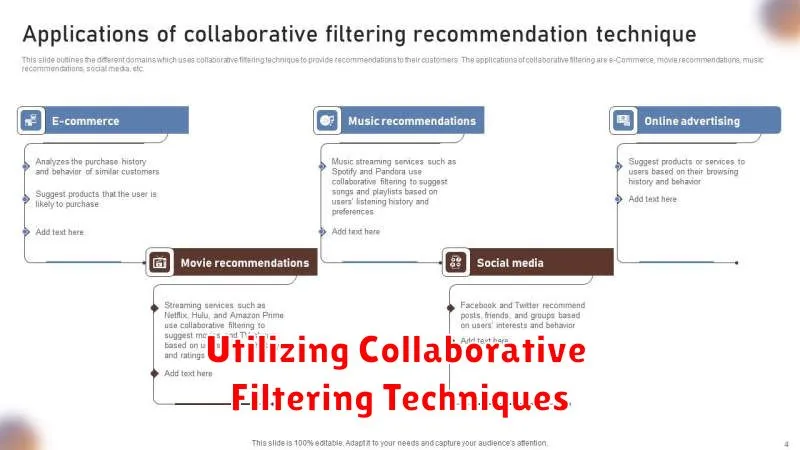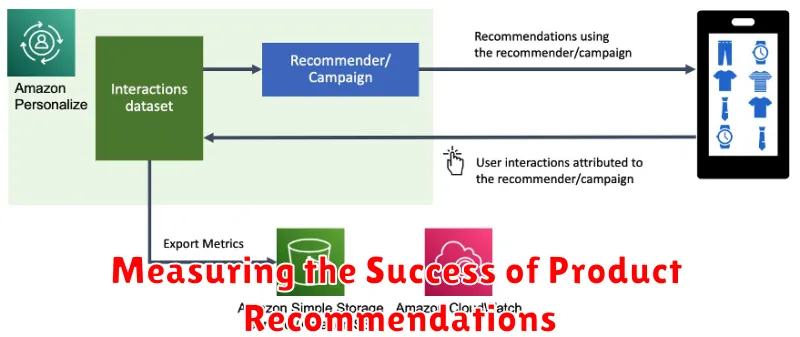In today’s competitive market, providing a personalized customer experience is paramount. Crafting personalized product recommendations has emerged as a crucial strategy for businesses seeking to enhance customer engagement and drive sales. By leveraging data and advanced algorithms, businesses can tailor product suggestions to individual customer preferences, needs, and behaviors. This approach not only increases the likelihood of conversions but also fosters customer loyalty and strengthens brand affinity. Understanding the nuances of personalized product recommendations is essential for businesses looking to stay ahead of the curve and cultivate meaningful customer relationships.
This article delves into the strategies and techniques involved in crafting personalized product recommendations that truly resonate with customers. We will explore the importance of data analysis, the role of customer segmentation, and the various recommendation algorithms available. From collaborative filtering to content-based filtering and hybrid approaches, we’ll examine how these methods can be effectively implemented to enhance customer engagement and maximize ROI. By understanding the power of personalization, businesses can unlock new opportunities for growth and cultivate lasting connections with their target audience. Discover how crafting personalized product recommendations can transform your customer experience and drive business success.
Understanding the Importance of Personalized Recommendations
In today’s competitive market, personalized product recommendations are crucial for enhancing customer engagement and driving sales. They transform the customer journey from a generic experience to a tailored interaction, fostering a sense of individual value.
Increased Conversion Rates are a direct benefit of personalization. By presenting customers with products aligned with their interests, the likelihood of purchase significantly increases. This targeted approach minimizes wasted browsing time and guides customers towards desired items.
Improved Customer Loyalty is another key outcome. When customers feel understood and valued, they are more likely to return for future purchases. Personalized recommendations demonstrate that a business cares about individual preferences, fostering a stronger customer-brand relationship.
Enhanced Customer Satisfaction results from a streamlined shopping experience. Instead of sifting through countless irrelevant products, customers are presented with options tailored to their needs. This ease of navigation and discovery enhances overall satisfaction and promotes a positive perception of the brand.
Data Collection and Analysis for Effective Personalization
Data collection forms the bedrock of effective personalized product recommendations. Gathering relevant data provides the necessary insights into individual customer preferences and behaviors. This data can be categorized into explicit and implicit data.
Explicit data is actively provided by the customer, such as through product ratings, reviews, and explicitly stated preferences in profiles. This information directly reflects customer opinions and desires.
Implicit data is gathered indirectly by observing customer behavior. This includes browsing history, purchase history, items added to carts, and even mouse movements and dwell times on particular products. While less direct, implicit data offers valuable insights into customer interests and potential future purchases.
Data analysis techniques, ranging from simple statistical analysis to complex machine learning algorithms, transform raw data into actionable information. Analyzing purchasing patterns, identifying correlations between products, and understanding individual customer journeys allows for the creation of highly targeted recommendations. This analysis helps predict future customer behavior and tailor product suggestions to individual needs and preferences. Effective data analysis ensures that recommendations are relevant and timely, maximizing their impact on customer engagement.
Leveraging Customer Segmentation for Targeted Recommendations
Customer segmentation plays a crucial role in delivering effective personalized recommendations. By dividing your customer base into distinct groups based on shared characteristics, you can tailor product suggestions to their specific needs and preferences. This targeted approach enhances the relevance of recommendations, leading to increased customer engagement and conversion rates.
Several key characteristics can be used for effective segmentation. Demographics such as age, gender, and location provide a foundational understanding of customer groups. Behavioral data, including past purchases, browsing history, and product ratings, offers valuable insights into individual preferences. Psychographic factors, like lifestyle, interests, and values, add a deeper layer of understanding, allowing for more nuanced recommendations. Finally, RFM (Recency, Frequency, Monetary) analysis helps identify high-value customers based on their purchase patterns.
Once segments are defined, tailored recommendation strategies can be implemented. For instance, new customers might benefit from recommendations of popular or trending items, while loyal customers might appreciate suggestions for exclusive products or early access to sales.
Utilizing Collaborative Filtering Techniques

Collaborative filtering is a powerful technique for generating personalized recommendations. It operates on the principle that users with similar past behaviors will likely have similar future preferences. This approach leverages the collective intelligence of a user base to predict individual preferences.
There are two primary types of collaborative filtering: user-based and item-based.
User-Based Collaborative Filtering
User-based collaborative filtering identifies users with similar purchase histories or product ratings. If User A and User B both highly rated products X, Y, and Z, and User A subsequently rates product W favorably, the system might recommend product W to User B.
Item-Based Collaborative Filtering
Item-based collaborative filtering, conversely, focuses on relationships between items. If users who purchase product X also frequently purchase product Y, the system might recommend product Y to a user who has just added product X to their cart. This method is often more computationally efficient than user-based filtering, especially with large datasets.
Implementing Content-Based Filtering Strategies
Content-based filtering focuses on recommending items similar to what a user has interacted with in the past. This approach relies heavily on understanding the characteristics of items and matching them to user preferences.
Item profiles are created, containing key features such as genre, actors, director (for movies), or author, keywords, topics (for books). These profiles are then compared to a user profile, representing the user’s interests based on their interaction history.
For example, if a user enjoys action movies starring a specific actor, the system will recommend other action movies featuring the same actor or similar actors. This approach requires effective feature extraction and similarity measurement techniques to ensure accurate matching.
A key advantage of content-based filtering is its ability to recommend niche items that may not be popular among other users. This can lead to the discovery of hidden gems and a more personalized experience.
Creating Hybrid Recommendation Systems for Optimal Results
Hybrid recommendation systems combine the strengths of multiple recommendation approaches to overcome the limitations of individual methods. This strategy often yields more accurate and relevant recommendations, leading to improved customer engagement and conversion rates.
A common hybrid approach merges content-based filtering with collaborative filtering. Content-based filtering suggests items similar to what a user has liked in the past, while collaborative filtering leverages the preferences of similar users. By combining these, the system can recommend items a user might not discover through either method alone.
Another popular hybrid strategy incorporates knowledge-based systems. These systems leverage specific domain expertise and product knowledge to offer personalized recommendations tailored to individual customer needs and preferences. Integrating knowledge-based systems can significantly improve the accuracy of recommendations, especially for complex or niche products.
Implementing a hybrid system requires careful consideration of the specific business needs and available data. The chosen approach should effectively address potential cold start issues, where limited user data hinders personalization. By carefully blending different recommendation methods, businesses can create robust and adaptable solutions that cater to diverse customer preferences.
The Role of AI and Machine Learning in Personalization
Artificial intelligence (AI) and machine learning (ML) are crucial for driving truly personalized product recommendations. Machine learning algorithms analyze vast datasets of user behavior, including past purchases, browsing history, and product ratings, to identify patterns and predict future preferences.
AI-powered systems can segment customers into distinct groups based on shared characteristics, enabling targeted recommendations. This granular approach moves beyond basic demographic segmentation to consider individual preferences and contextual factors, such as real-time browsing behavior and location. This allows for the delivery of highly relevant product suggestions, increasing the likelihood of conversion.
Furthermore, ML algorithms continuously learn and adapt as new data becomes available. This dynamic nature ensures that recommendations remain relevant and effective over time, even as customer preferences evolve. By leveraging AI and ML, businesses can create dynamic and personalized experiences that foster stronger customer engagement and drive sales.
Measuring the Success of Product Recommendations

Measuring the effectiveness of your product recommendation engine is crucial for continuous optimization and improved ROI. Key Performance Indicators (KPIs) provide quantifiable metrics to track progress and identify areas for refinement.
Common KPIs include Click-Through Rate (CTR), which measures how often users click on recommended products, and Conversion Rate (CVR), which tracks how often clicks lead to purchases. Monitoring these metrics helps assess the relevance of recommendations and their impact on sales.
Beyond CTR and CVR, consider measuring Average Order Value (AOV) to determine if recommendations are influencing purchase amounts. Also, track Customer Lifetime Value (CLTV) to understand the long-term impact of personalized recommendations on customer retention and profitability.
Regularly analyzing these metrics helps identify trends and optimize the recommendation engine for maximum impact. For example, low CTR may indicate irrelevant recommendations, while low CVR might suggest issues with product pages or pricing. By using data-driven insights, you can continuously improve the performance of your product recommendations and enhance the customer experience.
Best Practices for Delivering Personalized Experiences
Delivering truly personalized experiences requires careful consideration of several key practices. Context is paramount. Recommendations should align with the user’s current browsing session, past purchase history, and even real-time factors like location or weather.
Transparency and control are also crucial. Users should understand why they’re seeing specific recommendations and have the ability to adjust their preferences or opt-out entirely. This builds trust and empowers users to manage their own experience.
Testing and iteration are essential for optimization. A/B testing different recommendation strategies and algorithms allows for data-driven refinement, ensuring that recommendations continually improve over time. Regularly analyzing performance metrics provides insights into what resonates with users and what needs adjustment.
Finally, balance personalization with discovery. While tailored recommendations are valuable, introducing users to new and relevant products they might not have considered independently can broaden their horizons and increase engagement.

